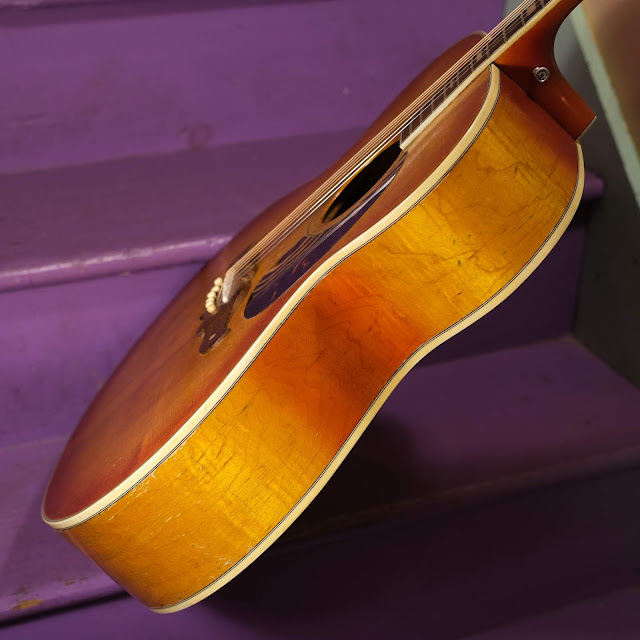1970s Harmony Opus XX Jumbo Flattop Guitar
While I've worked on a few Harmony Opus products, this is the first time I've worked on a full jumbo-sized (17" on the lower bout) one. I've never seen this model before and that's always a bit exciting. For those not in the know, Harmony Opus guitars were the last gasp of a company searching for some sort of market-share. They're higher-grade instruments than the concurrent Sovereign line and, while having features of the earlier Sovereigns, go beyond them and feature slimmer and faster "modern" necks and x-braced (rather than ladder-braced) tops.
Clearly, this is an attempt at a J-200 copy and, in all honesty, it sounds a lot better than many J-200s I've had in the shop. It's mellow, full, woody, and nicely-loud after work. I really, really like it.
Clearly, this example is also beat-up like crazy. A friend of mine bought it along with another guitar for an absurdly-low price due to the condition. This had no pickguard, missing board inlay, sprung plys at the endpin, and broken truss rod, and a neck falling-off when it came in.
Work involved resetting the neck, replacing the missing bits, installing a new truss rod (thankfully -- as easy as just slotting-in a new standard rod from the heel-side of the neck) leveling/dressing the frets, cutting a wider saddle slot and fitting a properly-compensated bone saddle, minor seam and popping-ply repairs to the sides, general cleaning, and a setup.
Like most Harmony acoustic products, it has a 25 1/8" scale length and thus feels slightly-less-tense than your average J-200. It also has an electric-like, fast neck which helps in that department, too.
While there could be more to do on this guitar in the future (the bridge will need to be reglued at some point and the raised-grain finish cracks on the top are questionable -- oh, and I didn't shim-up the fretboard extension when I reset the neck), I was happy with the way this guy turned-out. I was on a short timetable so the quick turnaround of a trainwreck felt pretty good.
It's harder to see in this light, but I replaced the missing inlay on the board with the same kind of cool tortoise as the pickguard. I figured my buddy would appreciate the wackiness of this. It looks fun when you catch it in natural light.
Look closely at the bridge -- I've slotted the top of the saddle to align the strings better with the neck. Harmony made thinner (side-to-side) necks for these Opus models but continued to use their old bridges from the '60s which were made for wider necks and thus have wider spacing at the bridge. Thus if you don't bring the string-spread in a bit, the strings are almost hanging off either edge of the fretboard... which is really irritating.
Harmony learned something from the Japanese guitars coming into the country -- ply's not so bad! The flamed-maple ply of the back and sides on this looks great.















Comments
https://jakewildwood.blogspot.com/2020/04/1970s-harmony-h6583-jumbo-flattop-guitar.html
I have had a Harmony H1265 Sovereign since high school in the 70's. As much as I love that guitar, it is a little "thin" for anything loud, and the Opus takes whatever I can throw at it. When we reworked the Opus we narrowed the string spacing slightly at the bridge, and my luthier friend added a slightly thicker neck binding to give me a smidge more width. The string spacing remains narrow in the higher frets, so any playing up there has to be very precise as there's no room to stretch out.
I also have an Opus V which I will rework in a similar manner. These were quality builds for the most part, and any deficiencies in the neck joints can be remedied. They sound good, and if you like a smaller neck they are an excellent find if you can get your hands on one. After almost 50 years they will need some work (like most any 70's guitar) but are well worth it. If you can't find one, I'd shoot for a vintage Takamine or Alvarez
https://newyork.craigslist.org/brk/msg/d/brooklyn-opus-acoustic-guitar/7326791658.html
https://www.guitar-auctions.co.uk/sale/191/the-guitar-auction---day-one---vintage%2C-classic-%26-modern-guitars%3A-part-one%2C-with-artist-associated-guitars-%26-memorabilia